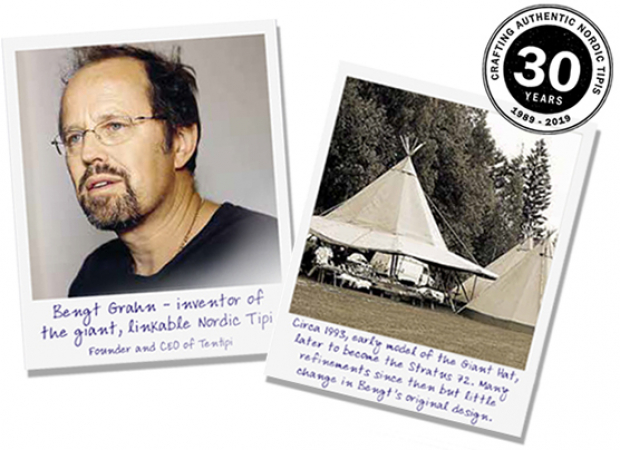2019 marks our 30th Birthday, a whole three decades since our founder and CEO, Bengt Grahn, started to make the prototype tents that now form the backbone of our global brand.
It was in 1989, in the village of Moskosel in Swedish Lapland, that Bengt had his ‘light bulb moment’ (he was actually changing a light bulb at the time), and decided that he would start making Nordic tipis. “I had a dream – to make the perfect tent. A tent to socialise around the fire. In Swedish Lapland. In the wilderness, near the Arctic Circle…”
As anyone who is familiar with Tentipi products probably knows, our tipi design was inspired by the kåta, a simple frame of wooden poles, covered by animal hides, with an opening at the top to let out smoke, used by the Sami people of northern Scandinavia. “…. In this harsh environment the Sami people have survived, through the ages, using the traditional Nordic tipis. We couldn’t have had a better starting point!”
Soon after the Adventure range of camping tipis was launched, work started on what was to become the Event range as we now know it. The development of the Stratus 72 - with sides that can be raised - marked the beginning of the giant Nordic tipi event industry that now reaches to all corners of the world. The continual refinement of joining techniques, and an almost limitless number of possible configurations, is what sets the Stratus 72 apart from other temporary structures used in the event industry. It is central to the Tentipi story.

© Love Tipis, www.lovetipis.co.uk
As word has spread about the Stratus we have sold into more and more countries, for an ever-expanding range of events. From English country weddings to a Norwegian ski jumping competition. From Australian beach parties to yoga retreats in California. From music festivals in Mauritius to a semi-permanent dining space in San Francisco. From VIP areas at Glastonbury Festival to corporate events in the United Arab Emirates. This list continues to grow.
Here’s to the growing global family of Tentipi customers. Here’s to another three decades of developing, innovating and crafting beautiful Nordic event tipis. Here’s to the next 30 years of Tentipi.
Related blog posts
Tentipi product design The Radial frame
30 Aug 2024
This apparently simple, but ingenious design by Bengt Grahn (founder of Tentipi) back in 1991, overcomes an age-old problem; how to stop rain from entering the top of a traditional Nordic tipi.
As with any great design, the radial frame solves a number of issues beyond making a Nordic tipi weatherproof.
Tentipi Event Tents are being used by an increasing number of hospitality businesses around the world for al fresco dining and socialising.
Quince is a three Michelin Star restaurant located in San Francisco’s historic Jackson Square. They are stocked with premium produce by their sister business, Fresh Run Farm, located just north of the city.
Inspiring structures for outdoor learning
28 Jun 2024
Tentipi Event Tents for Schools
Our tipis take inspiration from the kåta, the traditional home of the Sami people. We have combined this traditional design with innovative new features and premium materials to create extremely robust and long-lasting structures.
Prolong the life of your tents
27 Jun 2024
All of our products are designed and built to last. This ethos runs through everything we do, for the benefit of our customers and the planet. It is achieved using the highest quality materials and over 35 years of Tentipi expertise.
There is no definitive answer as to how long your tipi will last, but if well looked after you will get many years of use out of it.
There are several things you can do to prolong its life. Please have a read of our guide below. It's not everything there is to know, but it's a good place to start.
Lennart Pittja is a Sámi entrepreneur with a mission: with his world-renowned eco-tourism company he wants to spread the knowledge about his people – the Sami, indigenous of northern Scandinavia and Russia. With over 20 years of experience as a wildlife guide and nature photographer in the arctic region he started Sápmi Nature Camp. Where his guests stay in Nordic tipis from Tentipi on his reindeer herding land outside of Gällivare, in northern Sweden.
At Sapmi Nature camp you can experience real winter, see the northern lights, eat traditional Sami food, and have a cultural exchange in a genuine atmosphere. The scenic location has gained attraction from around the world. In 2017 it was listed by National Geographic as one of the top 21 places in the world to visit if you care about the planet.









